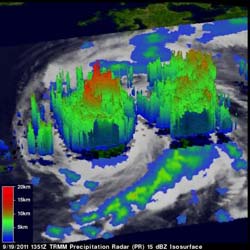NASA sees heavy rainfall in Typhoon Roke

This 3-D image created from the TRMM satellite's data shows convective storm towers near Typhoon Roke's center of circulation reached to heights of almost 15 km (~9.3 miles). Red indicates heavy rainfall (2 inches/50 mm per hour). Credit: Credit: SSAI/NASA, Hal Pierce<br>
Japanese authorities are calling for evacuations as Typhoon Roke nears because of flooding concerns. According to the Australian Broadcasting Corporation, about 1.1 million people in Nagoya in central Japan's Aichi prefecture were told to evacuate, and other cities in western Japan were given the same request. Heavy rains already occurring in Aichi on Sept. 20 were causing rivers to overflow, according to NHK news. Flash flooding and landslides are of particular concern, especially in the city of Nagoya.
The Tropical Rainfall Measuring Mission (TRMM) satellite passed over Typhoon Roke on September 18 at 1840 UTC (2:40 p.m. EDT). TRMM Precipitation Radar (PR) data showed that Roke contained several areas of heavy rainfall on the eastern side near the center of the storm. Some powerful storms near Roke's center were dropping rainfall at a rate greater than 50mm/hr (~2 inches). TRMM's Microwave Imager (TMI) also revealed that there was a large rain band between Roke and the main islands of Japan. TRMM shows that this large area of rainfall contained smaller lines of intense convective storms.
Tropical storm Roke already had a well defined circulation on September 18 at 1940 UTC (3:40 p.m. EDT) and when the TRMM satellite passed over Roke again on Sept. 19 at 1351 UTC (9:51 a.m. EDT) it had strengthened into a typhoon. TRMM captured the rainfall rates within Roke at that time. The infrared image was created at NASA's Goddard Space Flight Center in Greenbelt, Md. It was created using TRMM's Visible and InfraRed Scanner (VIRS) instrument overlaid with rainfall derived from TRMM PR and TMI data and showed that Roke had a well defined eye, circled by intense bands of rainfall.
A 3-D image of Roke was also created from TRMM data that showed the heights of the towering clouds near Roke's eyewall using data from TRMM Precipitation Radar (PR). Some powerful storms in Roke's eye wall reached to heights of almost 15 km (~9.3 miles). Roke's eye is about 15 miles in diameter and heavy rainfall surrounds it.
Japan's NHK news reported heavy rainfall already in parts of the Miyazaki Prefecture in Kyushu, where 400 millimeters (15.75 inches) had already fallen in one day and over 1,000 millimeters (39 inches) had fallen since last Thursday, so the ground is already saturated.
On Sept. 20 at 8 a.m. EDT Typhoon Roke's maximum sustained winds were near 115 knots (132 mph/213 kmh). It was centered 450 nautical miles (833 km/517 miles) southwest of Tokyo but its cloud cover and rains extend over the southern part of the big island of Japan. It was moving to the northeast at 14 knots (16 mph/26 kmh) and generating rough seas with heights to 26 feet (8 meters).
Roke is picking up speed and is expected to make landfall on Wednesday south of Tokyo while continuing to track to the northeast.
Media Contact
More Information:
http://www.nasa.govAll latest news from the category: Social Sciences
This area deals with the latest developments in the field of empirical and theoretical research as it relates to the structure and function of institutes and systems, their social interdependence and how such systems interact with individual behavior processes.
innovations-report offers informative reports and articles related to the social sciences field including demographic developments, family and career issues, geriatric research, conflict research, generational studies and criminology research.
Newest articles

Innovative 3D printed scaffolds offer new hope for bone healing
Researchers at the Institute for Bioengineering of Catalonia have developed novel 3D printed PLA-CaP scaffolds that promote blood vessel formation, ensuring better healing and regeneration of bone tissue. Bone is…

The surprising role of gut infection in Alzheimer’s disease
ASU- and Banner Alzheimer’s Institute-led study implicates link between a common virus and the disease, which travels from the gut to the brain and may be a target for antiviral…

Molecular gardening: New enzymes discovered for protein modification pruning
How deubiquitinases USP53 and USP54 cleave long polyubiquitin chains and how the former is linked to liver disease in children. Deubiquitinases (DUBs) are enzymes used by cells to trim protein…



